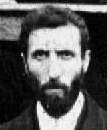

MALCOLM BINGHAM
“The ultimate tragedy of the Transformationalists lies not in their failure to achieve a single one of their aims but in the wasted life of Malcolm Bingham.”
Arthur Machen’s opinion of the failure of the Transformationalists does encapsulate the popular view of Malcolm Bingham. He is constantly dismissed as a mere forger and the blame for that is laid squarely at the Transformationalists’ door. Of the four founder members, Bingham is the only one who possessed an innate artistic talent. More than an embarrassment in an organisation which believed in the republic of Art. If Malcolm Bingham had allowed his gift for painting to flower in the natural way then whenever Frederick Hammersley asserted that “Everybody Is An Artist”, his audience would retort with “No, but he is”, and point at Malcolm Bingham.
In a perfect world where the caveman could paint whatever he wanted without Kipling’s devil peering over his shoulder, then everybody would be allowed to follow their own path and reveal their own gifts regardless of critical opinion. Inside the brotherhood of the Transformationalists such freedom would cause unnecessary complications. Some have blamed Frederick Hammersley, implying that he was jealous of Malcolm Bingham and envied him his god-given talent. It is true that Hammersley himself was talentless, unless a tenth muse be discovered, one for ‘les provocateurs’. However to judge by what little remains of his correspondence with Bingham, there are enough notes of interest and encouragement in relation to his colleague’s original work to lay to rest any attempt to cast Hammersley in the role of Svengali to Bingham’s Trilby.
Malcolm Bingham’s decision to devote most of his creative talents to forgery must be assumed to be his alone. And if this is accepted then we would do well to ignore Machen’s belief that this was tragic and examine it in a more positive light. What better way to attack the artistic establishment than by undermining its very foundation, its love of money: art as commerce, art as fashion, art as commodity, art as “a bag of taters” (as Hammersley declared it). By devoting his talent to producing forgeries, Bingham struck at the very heart of Transformationalism’s great enemy. To see his life’s work as some sad excuse to hide his talent in order to remain a member of the gang does nothing but rob the man of his greatest glory.
So, which of the world’s masterpieces were painted by Malcolm Bingham? The truth is no one knows. Obviously he kept no records, no statement of accounts, no details of commissions. A forger is a criminal and once his work is revealed as a forgery then it becomes drained of its worth, its significance and its beauty. There is a painting in the National Art Gallery in Washington D.C. which was originally thought to be by Vermeer. It hangs with the other Vermeers in the Collection and in my opinion it is by far the best. But it is a forgery. It is a portrait of a young girl and her face seems to leap off the canvas in a most disconcerting manner. If Vermeer had painted it then it would make Vermeer the greatest painter who ever lived. But it is a forgery. It has ceased to have any merit whatsoever. It remains my favourite painting and I would like to think that Malcolm Bingham painted it. Then there is Uccello’s ‘St. George And The Dragon’. Painted by Uccello this is a great painting, painted by Bingham it is a worthless piece of trash. Comparing it to an earlier treatment by Uccello of the same subject, it is difficult to see how any ‘expert’ could ever have declared it genuine. But there is no firm evidence to say it is a Bingham, it is all mere speculation. Who is to say it was not painted by Picasso? In which case of course it would immediately cease to be a worthless piece of trash and become great art once more. The world can transform art far more swiftly than art can transform the world.
Of Malcolm Bingham’s own original work, there is the white painting found in the cellar of the Burslem Old Town Hall and the so-called ‘lost masterpiece’ - “The World In Three Acts”. The latter is a triptych in conventional style detailing the state of the world as Bingham envisaged it. It is not known whether he ever completed it but in a letter to Frederick Hammersley (undated), he writes, “The first panel will show some toff being sick in a punt. The second shows mankind falling from the heavens. The third is a Garden of Earthly Delights.” It has been suggested that the first panel goes under the name of ‘Boulter`s Lock’ by E.J. Gregory and is currently in the possession of the Lady Lever Art Gallery, Port Sunlight. Of the two remaining panels, their whereabouts are unknown.

Back